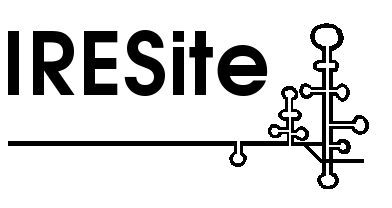|
|
 |
The nucleic acid data:
| |
|
|
IRESite record type:
 plasmid_with_promoter_and_putative_IRES_translationally_characterized
plasmid_with_promoter_and_putative_IRES_translationally_characterized
|
|
|
 |
IRESs:
| |
 |
IRES:
| |
|
|
|
 |
IRES trans-acting factor (ITAFS):
| |
 |
IRES trans-acting factor (ITAF):
| |
|
|
Type of the interaction between ITAF and the RNA subject to translation:
direct_interaction_with_rna
|
OPTIONAL: The interacting RNA base range (if any):
1033-1076
|
 |
ITAF protein characteristics:
| |
|
|
ITAF abbreviated name:
PTB-1
|
ITAF fullname:
polypyrimidine tract-binding protein isoform 1
|
ITAF description (long):
polypyrimidine tract-binding protein isoform 1 binds dsRNA with (CCU)n motif where n is at least 3. By SELEX
approach it was found it binds to 5'-CAGCCUGGUGCCUCUCUUUCGG-3' (Singh et al. (1995) Science 268:1173-1176)
but also UCUU or UCUUC within pyrimidine-rich sequence (Perez et al. (1997) RNA3:1334-1347).
|
|
|
 |
3.1.2. Organisms or in vitro systems where this ITAF was functionally studied:
| |
 |
Organism or in vitro system where ITAF was shown:
| |
Necessity of ITAF for translation in this particular organism or system:
required_and_must_be_supplemented
|
Method used to demonstrate ITAF effect:
in_vitro
|
In vitro system used to demonstrate ITAF effect:
rabbit reticulocytes lysate
|
|
|
|
|
Remarks:
Data from Figure 2I.
|
|
|
 |
Citations:
| |
|
|
|
|
 |
IRES trans-acting factor (ITAF):
| |
|
|
Type of the interaction between ITAF and the RNA subject to translation:
direct_interaction_with_rna
|
OPTIONAL: The interacting RNA base range (if any):
1033-1076
|
 |
ITAF protein characteristics:
| |
|
|
ITAF abbreviated name:
PTB-2
|
ITAF fullname:
polypyrimidine tract-binding protein isoform 2
|
ITAF description (long):
polypyrimidine tract-binding protein isoform 2 binds (CCU)n motif
|
|
|
 |
3.2.2. Organisms or in vitro systems where this ITAF was functionally studied:
| |
 |
Organism or in vitro system where ITAF was shown:
| |
Necessity of ITAF for translation in this particular organism or system:
required_and_must_be_supplemented
|
Method used to demonstrate ITAF effect:
in_vitro
|
In vitro system used to demonstrate ITAF effect:
rabbit reticulocytes lysate
|
|
|
|
|
Remarks:
Data from Figure 2I.
|
|
|
 |
Citations:
| |
|
|
|
|
 |
IRES trans-acting factor (ITAF):
| |
|
|
Type of the interaction between ITAF and the RNA subject to translation:
no_direct_interaction_with_rna
|
 |
ITAF protein characteristics:
| |
|
|
ITAF abbreviated name:
PTB-4
|
ITAF fullname:
polypyrimidine tract-binding protein isoform 4
|
ITAF description (long):
polypyrimidine tract-binding protein isoform 4 binds (CCU)n motif
|
|
|
 |
3.3.2. Organisms or in vitro systems where this ITAF was functionally studied:
| |
 |
Organism or in vitro system where ITAF was shown:
| |
Necessity of ITAF for translation in this particular organism or system:
no_effect_on_translation
|
Method used to demonstrate ITAF effect:
in_vitro
|
In vitro system used to demonstrate ITAF effect:
rabbit reticulocytes lysate
|
|
|
|
|
Remarks:
Data from Figure 2I.
|
|
|
 |
Citations:
| |
|
|
|
|
 |
IRES trans-acting factor (ITAF):
| |
|
|
Type of the interaction between ITAF and the RNA subject to translation:
direct_interaction_with_rna
|
OPTIONAL: The interacting RNA base range (if any):
1033-1076
|
 |
ITAF protein characteristics:
| |
|
|
ITAF abbreviated name:
nPTB
|
ITAF fullname:
polypyrimidine tract-binding protein isoform n
|
ITAF description (long):
neuronal polypyrimidine tract-binding protein isoform binds (CCU)n motif
|
|
|
 |
3.4.2. Organisms or in vitro systems where this ITAF was functionally studied:
| |
 |
Organism or in vitro system where ITAF was shown:
| |
Necessity of ITAF for translation in this particular organism or system:
required_and_must_be_supplemented
|
Method used to demonstrate ITAF effect:
in_vitro
|
In vitro system used to demonstrate ITAF effect:
rabbit reticulocytes lysate
|
|
|
|
|
Remarks:
Data from Figure 2I.
|
|
|
 |
Citations:
| |
|
|
|
|
 |
IRES trans-acting factor (ITAF):
| |
|
|
Type of the interaction between ITAF and the RNA subject to translation:
unknown
|
 |
ITAF protein characteristics:
| |
|
|
ITAF abbreviated name:
Unr
|
ITAF fullname:
upstream of N-ras
|
ITAF description (long):
Unr protein is known to bind to gaagaaguaa
|
|
|
 |
3.5.2. Organisms or in vitro systems where this ITAF was functionally studied:
| |
 |
Organism or in vitro system where ITAF was shown:
| |
Necessity of ITAF for translation in this particular organism or system:
no_effect_on_translation
|
Method used to demonstrate ITAF effect:
in_vitro
|
In vitro system used to demonstrate ITAF effect:
rabbit reticulocytes lysate
|
|
|
|
|
Remarks:
Data from Figure 2I.
|
|
|
 |
Citations:
| |
|
|
|
|
 |
IRES trans-acting factor (ITAF):
| |
|
|
Type of the interaction between ITAF and the RNA subject to translation:
unknown
|
 |
ITAF protein characteristics:
| |
|
|
ITAF abbreviated name:
La
|
ITAF fullname:
La autoantigen
|
ITAF description (long):
La autoantigen (p52), 52 kDa RNA binding protein, predominantly localized to nucleus, unwinds the dsRNA in
ATP-dependent manner, forms a dimer
|
|
|
 |
3.6.2. Organisms or in vitro systems where this ITAF was functionally studied:
| |
 |
Organism or in vitro system where ITAF was shown:
| |
Necessity of ITAF for translation in this particular organism or system:
no_effect_on_translation
|
Method used to demonstrate ITAF effect:
in_vitro
|
In vitro system used to demonstrate ITAF effect:
rabbit reticulocytes lysate
|
|
|
|
|
Remarks:
Data from Figure 2I.
|
|
|
 |
Citations:
| |
|
|
|
|
|
|
 |
Regions with experimentally determined secondary structures:
| |
 |
A region with the experimentally determined secondary structure:
| |
|
|
|
|

